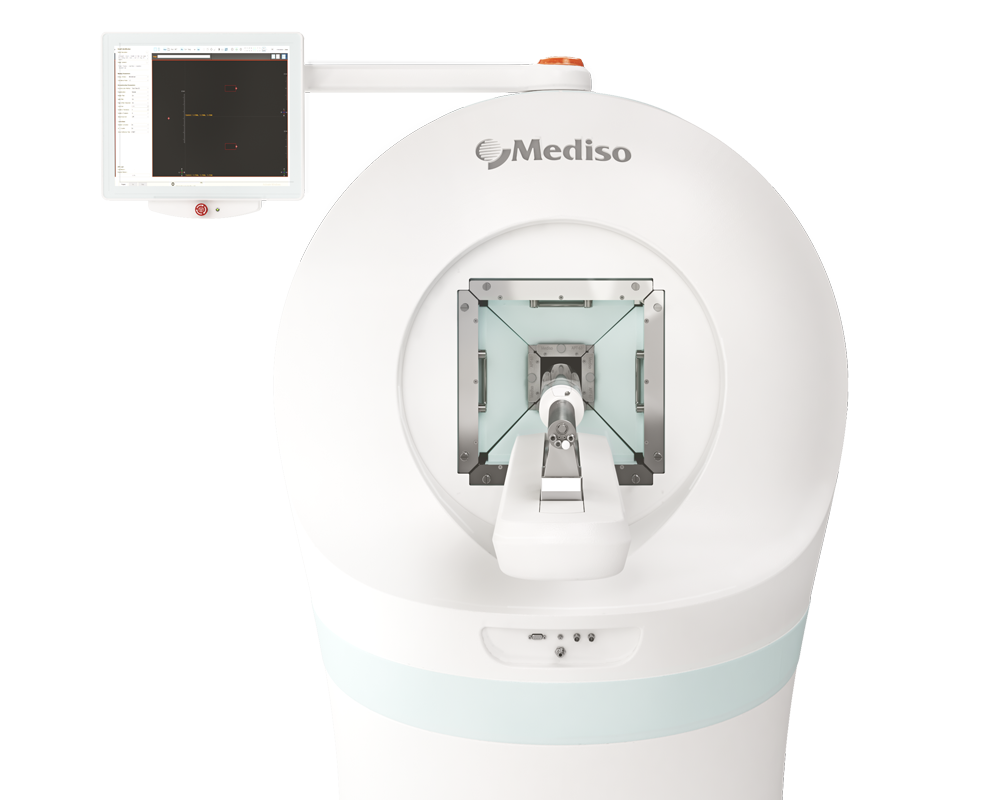Preclinical characterisation of gallium 68 labeled ferrichrome siderophore stereoisomers for PET imaging applications
2024.03.04.
Kristyna Krasulova et al, EJNMMI Radiopharmacy and Chemistry, 2024
Summary
Siderophores are small iron-binding molecules produced by microorganisms to facilitate iron acquisition from the environment. Radiolabelled siderophores offer a promising solution for infection imaging, as they can specifically target the pathophysiological mechanisms of pathogens. Gallium-68 can replace the iron in siderophores, enabling molecular imaging with positron emission tomography (PET). Stereospecific interactions play a crucial role in the recognition of receptors, transporters, and iron utilisation. Furthermore, these interactions have an impact on the host environment, affecting pharmacokinetics and biodistribution. This study examines the influence of siderophore stereoisomerism on imaging properties, with a focus on ferrirubin (FR) and ferrirhodin (FRH), two cis–trans isomeric siderophores of the ferrichrome type. Siderophores were labelled with gallium-68 with high radiochemical purity. The resulting complexes differed in their in vitro characteristics. [68Ga]Ga-FRH showed less hydrophilic properties and higher protein binding values than [68Ga] Ga-FR. The stability studies confirmed the high radiochemical stability of both [68Ga]Gasiderophores in all examined media. Both siderophores were found to be taken up by S. aureus, K. pneumoniae and P. aeruginosa with similar efficacy. The biodistribution tested in normal mice showed rapid renal clearance with low blood pool retention and fast clearance from examined organs for [68Ga]Ga-FR, whereas [68Ga]Ga-FRH showed moderate retention in blood, resulting in slower pharmacokinetics. PET/CT imaging of mice injected with [68Ga]Ga-FR and [68Ga]Ga-FRH confirmed findings from ex vivo biodistribution studies. In a mouse model of S. aureus myositis, both radiolabeled siderophores showed radiotracer accumulation at the site of infection. In conclusions, the 68Ga-complexes of stereoisomers ferrirubin and ferrirhodin revealed different pharmacokinetic profiles. In vitro uptake was not affected by isomerism. Both compounds had uptake with the same bacterial culture with similar efficacy. PET/CT imaging showed that the [68Ga]Ga-complexes accumulate at the site of S. aureus infection, highlighting the potential of [68Ga]Ga-FR as a promising tool for infection imaging. In contrast, retention of the radioactivity in the blood was observed for [68Ga]Ga-FRH. Results suggest that the stereoisomerism of potential radiotracers should be considered, as even minor structural differences can influence their pharmacokinetics and, consequently, the results of PET imaging.
Results from nanoScan® PET/CT
In vivo uptake of [68Ga]Ga-FR and [68Ga]Ga-FRH was studied in a murine model of acute myositis in immunosuppressed BALB/c mice. An intraperitoneal injection of cyclophosphamide was administered five and one day before the infection. On the day of infection, all mice received an intramuscular injection of 50 µl of bacterial culture containing S. aureus into the muscle of their left hind leg. To assess the specificity of in vivo uptake of [68Ga]Ga-FR or [68Ga]Ga-FRH, saline and heat-inactivated S. aureus culture was injected into the right hind leg muscle of the animal. The microbial infection was allowed to develop for 5 h, and after that, mice were scanned on PET/CT using tested 68Ga-siderophores. For that, mice were injected retroorbitally with [68Ga]Ga-FR or [68Ga]Ga-FRH at a dose of 5–8 MBq. Static PET imaging was initiated at 30 and 90 min p.i. Dynamic imaging studies were started ∼ 5 min p.i. Single field-of-view PET scans were performed, followed by whole-body CT scans. Image reconstruction was performed using Mediso Tera-Tomo 3D PET iterative reconstruction (Mediso Medical Imaging Systems, Budapest, Hungary). Images were visualised, processed, and quantified using Mediso InterView FUSION.
Ex vivo biodistribution studies were performed in healthy BALB/c mice. Mice were r.o. injected with [68Ga]Ga-FR or [68Ga]Ga-FRH (1-2 MBq). All mice were sacrificed 30 and 90 min after injection under general anaesthesia by cervical dislocation followed by exsanguination. Blood, spleen, pancreas, stomach, intestine, kidneys, liver, heart, lung, muscle, and bone were collected; then, the organs and tissues were weighed, and radioactivity was measured using the γ-counter. Biodistribution data were calculated as the percentage of injected dose per gram of tissue (% ID/g).
Results show:
- The biodistribution of [68Ga]Ga-FR in healthy BALB/c mice exhibited rapid renal clearance with low blood pool retention and fast clearance from examined organs (Fig. 5)
- [68Ga]Ga-FRH showed moderate retention in blood with slightly higher accumulation in perfused organs. The highest activity concentration in the studied organs at late time points was found for kidneys and lungs (Fig. 5)
 Fig. 5 Ex vivo biodistribution of [68Ga]Ga-FR and [68Ga]Ga-FRH in healthy BALB/c mice 30- and 90- min p.i
Fig. 5 Ex vivo biodistribution of [68Ga]Ga-FR and [68Ga]Ga-FRH in healthy BALB/c mice 30- and 90- min p.i
PET/CT imaging of mice injected with [68Ga]Ga-FR or with [68Ga]Ga-FRH confirmed the data from ex vivo biodistribution studies:
- [68Ga]Ga-FR was rapidly cleared from the bloodstream via renal excretion.
- [68Ga]Ga-FRH showed retention in the bloodstream and several organs (Figs. 6 and 7).

Fig. 6 Maximum intensity projection (MIP) PET/CT images of in vivo [68Ga]Ga-FR and [68Ga]Ga-FRH biodistribution in healthy mice 30 and 90 min after injection of [68Ga]Ga-FR/FRH

Fig. 7 MIP images of PET dynamic in vivo study of [68Ga]Ga-FR and [68Ga]Ga-FRH biodistribution in healthy mouse up to 90 min after administration
- In the mouse model of S. aureus myositis, the infected left hind leg showed a significant gallium-68 accumulation after [68Ga]Ga-FR injection.
- Similar signal accumulation at the site of infection was obtained using [68Ga]GaFRH.
- However, the PET signal was also present in other organs, making this radiotracer unsuitable for infection imaging (Fig. 8).
- The right hind legs of infected mice injected with saline or heat-inactivated bacteria showed no PET signal for [68Ga]Ga-FR or significantly reduced signal for [68Ga]Ga-FRH.

Fig. 8 MIP PET/CT images of a mouse model of S. aureus myositis in the left hind leg (red arrow) using [68Ga] Ga-FR and [68Ga]Ga-FRH, while the right hind leg received a saline injection or heat-inactivated S. aureus (SA) culture. These MIP images were obtained 5 h after infection and 45 min after radiocomplex administration
Full article on ejnmmipharmchem.springeropen.com
W czym możemy pomóc?
Skontaktuj się z nami aby uzyskać informacje techniczne i / lub wsparcie dotyczące naszych produktów i usług.
Napisz do nas
